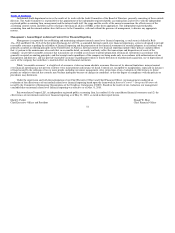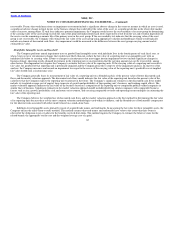Nike 2010 Annual Report Download - page 65
Download and view the complete annual report
Please find page 65 of the 2010 Nike annual report below. You can navigate through the pages in the report by either clicking on the pages listed below, or by using the keyword search tool below to find specific information within the annual report.
Table of Contents NIKE, INC.
NOTES TO CONSOLIDATED FINANCIAL STATEMENTS — (Continued)
recoverable. Factors that would necessitate an impairment assessment include a significant adverse change in the extent or manner in which an asset is used,
a significant adverse change in legal factors or the business climate that could affect the value of the asset, or a significant decline in the observable market
value of an asset, among others. If such facts indicate a potential impairment, the Company would assess the recoverability of an asset group by determining
if the carrying value of the asset group exceeds the sum of the projected undiscounted cash flows expected to result from the use and eventual disposition of
the assets over the remaining economic life of the primary asset in the asset group. If the recoverability test indicates that the carrying value of the asset
group is not recoverable, the Company will estimate the fair value of the asset group using appropriate valuation methodologies which would typically
include an estimate of discounted cash flows. Any impairment would be measured as the difference between the asset groups carrying amount and its
estimated fair value.
Identifiable Intangible Assets and Goodwill
The Company performs annual impairment tests on goodwill and intangible assets with indefinite lives in the fourth quarter of each fiscal year, or
when events occur or circumstances change that would, more likely than not, reduce the fair value of a reporting unit or an intangible asset with an
indefinite life below its carrying value. Events or changes in circumstances that may trigger interim impairment reviews include significant changes in
business climate, operating results, planned investments in the reporting unit, or an expectation that the carrying amount may not be recoverable, among
other factors. The impairment test requires the Company to estimate the fair value of its reporting units. If the carrying value of a reporting unit exceeds its
fair value, the goodwill of that reporting unit is potentially impaired and the Company proceeds to step two of the impairment analysis. In step two of the
analysis, the Company measures and records an impairment loss equal to the excess of the carrying value of the reporting unit’s goodwill over its implied
fair value should such a circumstance arise.
The Company generally bases its measurement of fair value of a reporting unit on a blended analysis of the present value of future discounted cash
flows and the market valuation approach. The discounted cash flows model indicates the fair value of the reporting unit based on the present value of the
cash flows that the Company expects the reporting unit to generate in the future. The Company’s significant estimates in the discounted cash flows model
include: its weighted average cost of capital; long−term rate of growth and profitability of the reporting unit’s business; and working capital effects. The
market valuation approach indicates the fair value of the business based on a comparison of the reporting unit to comparable publicly traded companies in
similar lines of business. Significant estimates in the market valuation approach model include identifying similar companies with comparable business
factors such as size, growth, profitability, risk and return on investment, and assessing comparable revenue and operating income multiples in estimating the
fair value of the reporting unit.
The Company believes the weighted use of discounted cash flows and the market valuation approach is the best method for determining the fair value
of its reporting units because these are the most common valuation methodologies used within its industry; and the blended use of both models compensates
for the inherent risks associated with either model if used on a stand−alone basis.
Indefinite−lived intangible assets primarily consist of acquired trade names and trademarks. In measuring the fair value for these intangible assets, the
Company utilizes the relief−from−royalty method. This method assumes that trade names and trademarks have value to the extent that their owner is
relieved of the obligation to pay royalties for the benefits received from them. This method requires the Company to estimate the future revenue for the
related brands, the appropriate royalty rate and the weighted average cost of capital.
62
























